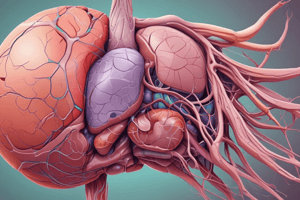Podcast
Questions and Answers
What is the approximate weight of the liver?
What is the approximate weight of the liver?
- 2.0 Kg
- 1.5 Kg (correct)
- 1.0 Kg
- 3.0 Kg
What is one of the functions of the liver?
What is one of the functions of the liver?
- To regulate body temperature
- To filter waste from the blood like creatinin
- To produce growth hormones
- To synthesize plasma proteins (correct)
What is the structure that covers the liver?
What is the structure that covers the liver?
- Fibrous tunic
- Glisson capsule (correct)
- Mesentery
- Peritoneum
What is the shape of the hepatic lobules?
What is the shape of the hepatic lobules?
What is the structure found in the portal space?
What is the structure found in the portal space?
What is the name of the area formed by 3 regions of 3 adjoining hepatic lobules?
What is the name of the area formed by 3 regions of 3 adjoining hepatic lobules?
What is the structure that drains the hepatic acinus?
What is the structure that drains the hepatic acinus?
How are the hepatocytes arranged?
How are the hepatocytes arranged?
What is the space between the lining of hepatic sinusoids and hepatocytes known as?
What is the space between the lining of hepatic sinusoids and hepatocytes known as?
What is the purpose of the bile canaliculi?
What is the purpose of the bile canaliculi?
What percentage of liver cells have two nuclei?
What percentage of liver cells have two nuclei?
What is the direction of bile flow in the liver?
What is the direction of bile flow in the liver?
What is the function of the Kupffer cells?
What is the function of the Kupffer cells?
What is the name of the vein that carries oxygen-rich blood to the liver?
What is the name of the vein that carries oxygen-rich blood to the liver?
What is the name of the duct that receives bile from the gallbladder and forms the common bile duct?
What is the name of the duct that receives bile from the gallbladder and forms the common bile duct?
What is the name of the vein that carries blood from the liver to the vena cava?
What is the name of the vein that carries blood from the liver to the vena cava?
Flashcards are hidden until you start studying
Study Notes
The Liver
- The liver is the largest organ in the body, weighing approximately 1.5 kg, with the exception of the skin.
- Functions of the liver:
- Major role in lipid, carbohydrate, and protein metabolism
- Inactivates and detoxifies drugs and substances through oxidation, conjugation, etc.
- Participates in iron metabolism
- Produces bile
- Synthesizes plasma proteins and blood coagulation factors
Liver Histology
- The liver is covered by a thin connective tissue capsule called the Glisson capsule
- The capsule sends trabeculae that divide the liver into lobules called hepatic lobules
- Each hepatic lobule is hexagonal in shape, with a central vein and portal spaces at each angle
- The portal space contains the portal triad:
- Branch of portal vein
- Arteriole branch of hepatic artery
- Interlobular bile duct lined by simple cuboidal epithelium
- Lymphatic vessels (not very important)
Hepatic Lobules and Acini
- Hepatic lobule: a triangular area with a portal space in the center and a central vein at each angle
- Hepatic acinus: represents the part of 2 adjacent areas of 2 different hepatic lobules
- Hepatic acinus is supplied by terminal branches of the hepatic portal vein, terminal branches of the hepatic artery, and drained by terminal branches of the bile duct
- Three zones can be distinguished in the hepatic acinus: Zone 1, Zone 2, and Zone 3
Hepatocytes
- Hepatocytes are arranged in plates and are anastomosed freely with the central vein
- The space between the plates of hepatocytes is occupied by sinusoids
- The surface of each hepatocyte contacts the wall of sinusoids through the space of Disse
- Hepatocytes have large, rounded, centrally located nuclei (most cells have one nucleus, and 15% have 2 nuclei)
Bile Canaliculi and Ducts
- Bile canaliculi: the first portion of the bile duct system, formed by the plasma membrane of two hepatocytes
- Bile flow is in the opposite direction of blood flow, from the center of the classic lobule to its periphery
- Bile enters the bile ductule (Hering's canal) and then becomes the interlobular bile ducts, which fuse to form the right and left hepatic ducts
- The common hepatic duct receives the cystic duct from the gallbladder and forms the common bile duct, which drains into the duodenum
Liver Sinusoids
- Liver sinusoids have an irregular outline and a discontinuous layer of fenestrated endothelial cells
- In addition to lining epithelial cells, there are phagocytic cells known as Kupffer cells
- The space between the lining hepatic sinusoid and hepatocytes is known as the space of Disse
Liver Blood Supply
- The liver receives blood from two sources:
- Portal vein, carrying oxygen-poor, nutrient-rich blood from the abdominal visceral organs
- Hepatic artery, supplying oxygen-rich blood
Studying That Suits You
Use AI to generate personalized quizzes and flashcards to suit your learning preferences.




